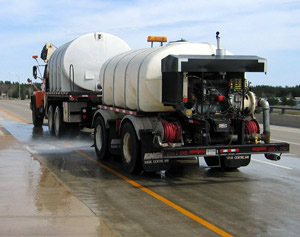 |
 |
|
 |
Pre-fabricated concrete sections offer quick replacements on Hwy 62 in Minneapolis |
 |
 |
 |
|
Contractor’s employees ready a pre-fabricated concrete pavement section for installation. Photo by Ben Timerson |
Sections of concrete pavement ready-made and ready to go enabled the Metro District to replace damaged sections of Hwy 62 (the Crosstown Highway) in a unique and timely fashion.
The work took about two days rather than a week the standard method would require.
That’s crucial in such a heavily traveled corridor.
Hwy 62 connects Interstate 494/I-35W travelers with the Mall of the America, the Minneapolis-St. Paul International Airport, St. Paul’s southern suburbs and many other destinations.
“We could use the regular method that would require about six days to cure or another method that cures much more quickly but creates a pavement that isn’t as durable,” said Kevin Hagness, project engineer, Metro District Construction.
“The intent of this project is to determine if we can use the process overnight to get a more durable pavement than the methods we now use,” Hagness said.
Hence, the fully cured, pre-fab panels. Each of the 18 panels is a 12-foot square, 9.3 inches thick, that weighs about eight tons. Together, they replace more than 200 feet of damaged pavement in the highway’s right driving lane.
This marks the first time Mn/DOT used this method for pavement.
The lane sections were built in Wisconsin and then trucked to the Twin Cities.
In order to limit traffic disruption to a minimum, the Metro District worked with the Office of Materials to use the pre-fabricated sections. Before the pavement sections were lifted into place by a crane, the old concrete was saw cut, removed, and the roadbed material leveled to ensure the panels would work as designed.
Hagness said the main benefit the test seeks is the ability to repair conditions such as concrete blow-ups as quickly as possible.
There’s no stopping the traffic out there,” he said. “With a method like this, we can get in and get out within hours and get the traffic rolling again.
By Craig Wilkins
|
back

|
 |
District Court to review governor’s list of critical state functions |
 |
 |
The Ramsey County District Court is scheduled June 23 to evaluate the list of critical services the Pawlenty-Molnau administration believes should remain open in the event of a partial state shutdown on July 1. Under the state constitution, the court decides if the services on the list are critical life, health and safety functions and must remain open during a shutdown.
Included in the governor’s list are active state highway and bridge construction projects; Stillwater Lift Bridge operations, and operation of ramp meters and MnPass express lanes. Other transportation-related critical functions identified by the governor include responding to hazardous material incidents, assessing traffic damage to bridges, maintaining aeronautic navigation and pilot weather information systems, and continuing payment processing for active county/municipal state aid projects.
Bob Winter, District Operations Division director and agency lead on shutdown preparations, will represent Mn/DOT at the court hearing and testify if needed regarding Mn/DOT’s list of critical functions.
For more information, read:
These sites are expected to change as more information becomes available, so check back often.
|
back

|
 |
Last day of spring erupts in road-damaging bursts of wind, rain |
 |
 |
 |
|
A six-mile section of Hwy 78 between Ottertail and Battle Lake was especially hard hit on June 20 by winds of up to 90 miles an hour. This road is just off Hwy 78, Photo by Dennis Redig |
A long, unusually wet spring ended with an eruption of wind and water June 20 that flooded some highways in Minnesota and hammered trees in rest areas and along roadsides.
Detroit Lakes/District 4 took a hit from the wind in several locations. In some places, 80 to 90 miles an hour gusts littered the highways with trees, downed power lines and other debris.
Dennis Redig, maintenance superintendent at Detroit Lakes, said a six-mile section of Hwy 78 between Ottertail and Battle Lake was especially hard hit.
The roadway, he said, was covered with downed trees.
Lee Berget, district engineer, said the crews reopened Hwy 78 in only about six hours after the storm hit at 10:30 a.m.
“Their response and the work they did is amazing given the hundreds of trees that the winds took down,” Berget said.
The storm forced closing Mn/DOT’s rest area that parallels the shore of Otter Tail Lake along Hwy 78.
Immediately after the storm, district maintenance crews helped clear a path through the tree-strewn highway so emergency crews could help people trapped in the cab of a semi-trailer truck apparently blown over by the sudden gusts, said Judy Jacobs, district public affairs coordinator.
Fierce winds also uprooted trees along Hwy 29 near Henning and Hwy 108 near Dent, Redig said.
Crews from throughout the district have been working since the storm hit to clear the affected highways.
Speaking of the work on Hwy 78, Redig said, “We’ve got it cleared to the shoulder; now we’re working on clearing it to the edge of the right of way.”
Maintenance crews from the district also helped drain flooded streets, storm sewers and underpasses in the city of Moorhead.
Redig was philosophical about the damage the district suffered from the storm.
“It’s been a very interesting year, so far,” he said.
By Craig Wilkins
Storm literally hits home for District 4 employee
The June 20 storm that caused widespread damage in the Detroit Lakes district also zeroed in on at least one district employee, Brent Thompson, a transportation generalist at the Henning truck station.
As one half of a modular home purchased by Thompson was being lifted onto to its foundation, a fierce gust of wind caught the structure, flipped it and then dropped it on his camper parked nearby.
The camper had been Thompson’s temporary residence. That is, until the modular house section and a power pole it dragged along crashed into the trailer and destroyed it.
Thompson said the crew assembling the house received a warning, that came seconds too late, to not move the modular sections. When the winds hit, Thompson was running an errand at the hardware store.
This is the second home Thompson has lost this year. The first was destroyed by fire in January.
Thompson said, however, things are looking up for now.
“The modular home factory put us at the top of their priority list, so we should have the rest of the house in a few weeks,” he said.
|
|
back

|
 |
New operations plan sets direction to better manage Minnesota’s highway system
|
 |
 |
 |
|
Bridge-flushing tankers such as these used by District 3 to help extend bridge life by washing away sand and other debris that can damage hinges, pins and other moving parts. Photo by Rick Pickar |
A new, comprehensive plan outlines how Mn/DOT can meet its highway operations performance goals by more effective management of existing resources such as roads, bridges, buildings and vehicle fleets.
The document is known as the Highway Systems Operations Plan. The HSOP earned final approval in May after a one-year effort to create it, said Mitch Webster, HSOP project manager, Office of Investment Management.
“The HSOP complements the State Transportation Improvement Plan, the districts’ long-range capital improvement plans and the Comprehensive Highway Safety Plan,” said Bob Winter, director of the District Operations Division.
Winter said the plan is the first of its kind completed by a state DOT.
The plan is performance-based; that is, it will determine how resources are distributed based on how well they resolve unmet performance standards set forth in the plan.
The HSOP also sets the performance framework for Mn/DOT’s budget request to shift about $9.5 million from capital improvement projects to operations.
“Those funds and the performance targets established in the HSOP will enable us to take real, actionable steps to make needed operational improvements,” he said.
For example, Winter said added support for operations will allow Mn/DOT to reduce its cycle of retiming traffic signals operations to meet changing traffic management needs from its current 16-year cycle to the plan’s recommended four-year cycle.
In addition to improving operations, the plan also seeks more coordination between staff planning new construction and those who manage operations such as preventive pavement maintenance, snow and ice removal and fleet management, said Gary Niemi, area maintenance engineer at Baxter and a plan development leader.
Niemi said the plan represents a shift from construction to protecting Mn/DOT’s multi-billion dollar investment in the state’s highway system.
“Our HSOP provides a map for Mn/DOT to plot our priorities in an orderly, measured way,” Winter said. “It reflects what we know, what we’re learning and how we can apply that knowledge to provide the transportation services Minnesotans need."
Niemi said, for example, that added support for preventive maintenance would enable districts to extend the life of existing highways and bridges and help avoid expensive repair work to keep them serviceable and performing efficiently.
Sue Mulvihill, Metro District maintenance engineer, said the new plan represents an important first step to assess the challenges of preserving the state highway system when resources are limited and user needs continue to grow.
“Since I came to work at Mn/DOT I’ve had the radical notion that we should identify the amount of work we do versus the work we should do,” she said. “The plan is a living document that will move us toward measuring how we impact customers and will show what we have accomplished, for example, to minimize the impact of congestion and how well we manage the highway system.”
By Craig Wilkins
|
back

|
 |
Restructuring two offices will help support statewide communications needs |
 |
 |
Three functional areas within the Office of Traffic, Security and Operations will join the Office of Electronic Communications on July 1.
Bernie Arseneau, director of TSO, said the change was made to bring staff who are expert in areas such as fiber optic, radio and microwave communications together in one unit.
Combining the areas, Arseneau said, will enable staff to share their expertise more fully to meet the increasing statewide demand to use more advanced communication technologies.
The affected functional areas are freeway management system design, freeway management system maintenance and systems integration. Staff in those units previously reported to Jim Kranig, assistant state traffic engineer.
Tim Lee, assistant OEC director, said the change will, for example, provide more support for Mn/DOT’s traffic management system including the eight transportation operations communications centers located throughout the state.
They will support the operation of traffic cameras, ramp meters, changeable message signs and other electronic methods to improve highway safety and capacity.
“Their skills and expertise in areas such as wireless networks, two-way radio systems and fiber optic-based communication systems will allow Mn/DOT to, for example, expand its 800 Megahertz emergency radio system from beyond the Twin Cities metropolitan area to St. Cloud and Rochester,” Lee said.
Marthand Nookala, director of the Operations, Safety and Technology Division, said the realignment of the functions reflects changes in the transportation industry and the evolution of technology.
The division includes both offices affected by the restructuring.
“This change,” Nookala said, “also reflects both our growing expertise and the increasing need to support electronic traffic management and other communications functions statewide.”
|
back

|
 |
Keeping sensitive information secure is aim of new policy |
 |
 |
What security-sensitive information is and who has access to it are at the heart of a new information security policy recently approved by Commissioner’s Staff.
In fact, information security is so important that in order to access the policy itself, employees must use a password, according to Sonia Pitt, Mn/DOT’s homeland security director.
The Minnesota Government Data Practices Act defines “security information” as data whose disclosure would “substantially jeopardize the security of information, possessions, individuals or property against theft, tampering, improper use, attempted escape, illegal disclosure, trespass or physical injury.”
The new policy, which applies to all permanent and temporary employees, outlines 20 classes of security-sensitive information for Mn/DOT, which include:
-
Disaster recovery, emergency response and homeland security plans
-
Vulnerablity/risk assessments of critical infrastructure or facilities
-
Internal and external meeting minutes concerning security sensitive information
-
Lists of hazardous materials shippers
-
Any current or future hazardous materials commodity flow studies
-
Procedures and decisions in response to identified national, state and maritime threat levels
-
Laptops that contain security sensitive information, such as those with geographical, utility and contact information
Mn/DOT has a limited number of employees who have security clearances. These are the people who require access to sensitive information as a frequent part of their official duties, including top management, homeland security staff and other employees on a case-by-case basis.
Sensitive information created by employees during the course of their duties needs to be protected, Pitt said. This means, for example, that computer files containing sensitive information can not be stored on a shared drive or folder, and paper files (including engineer specs and photos) must be stored in a locked cabinet clearly marked as non-public, sensitive data.
For more information, go to: Homeland Security security policy (employees will need to use their log on and password).
|
back

|
 |
Signs, signs, everywhere a sign: traffic safety experts eye ones that work best |
 |
 |
 |
|
Testers were asked to compare the above signs to determine which was the most visible, most understandable and able to be seen from the farthest distance..Photo by David Gonzalez |
Participants in a statewide June 15 work zone safety demonstration received a pencil, a brightly colored clipboard, a packet of papers and an assignment.
The assignment was to observe a series of traffic signals and devices as the participants were driven past them. They recorded their notes and comments on automated flagging devices, remotely controlled “stop” and “slow” signs and several kinds of flagging signs.
The demonstration meeting was held at the 3M Transportation Safety Center in Cottage Grove. Participants included members and guests from the Northland Chapter of the American Traffic Safety Services Association. Participants were mostly maintenance and construction supervisors, traffic managers and safety officers.
One of the tasks that the participants had to observe and comment on were three flagger signs side-by-side. One of the flagger signs had blinking lights around its border, one had fluorescent sheeting, and the third had a bright green outline. In this case, participants were asked to compare which sign was the most visible, understandable and able to be seen from the farthest distance.
Besides driving past signs and devices, participants also got a chance to examine new signs up close. These new signs have larger and clearer font as well as new sheeting.
“We want everyone on the road, young or old, to be able to read and see signs and devices,” said Jon Jackels, pavement markings, work zone products evaluation engineer. “We’re looking for input in the performance of new sign sheeting material and new fonts for the word messages on both permanent and work zone signs.”
During the evening session, a device that simulates rain gave participants an opportunity to evaluate how signs and other traffic control devices perform in wet and dark weather.
“The wet night pavement marking demonstration was the first time many of the participants were exposed to markings that reflected at night during wet weather,” he said.
After dark, different kinds of reflective materials and devices that guide motorists during nighttime driving were available for participants to comment on and examine.
“We want participants to take home new tools for their traffic engineering and traffic safety ‘tool boxes,’” said Jackels.
By Lisa Yang
|
back

|
 |
Paperless timesheets coming to a district near you |
 |
 |
 |
|
Mike McNeally, Office of Information Technology, trains district payroll administrators in use of the new RCA paperless timesheet system. Photo by Mike Garza |
The paper timesheet will soon be a thing of the past.
A paperless timesheet system was implemented through the Resource Consumption Application in Mn/DOT’s Central Office in April. Recently, all district payroll administrators were trained on how to implement paperless timesheets and conduct training in their respective districts. They also learned how CO has been processing the new system, which will soon be available to all district employees.
“This is a significant achievement for Mn/DOT,” said Mike Garza, director, Business and Support Services.
"Going to paperless timesheets in the Central Office has been a great step toward delivering another important e-government service to employees. Now we want to build on that success in the districts.” Garza is working with the District Administrative Managers to assist in the development of implementation schedules for their districts.
The new system has great potential to save staff time previously spent collecting, collating, routing, filing and storing paper timesheets. It will also save money by freeing up staff for other activities. And, timesheets can now be stored electronically, which will save space.
“Retention schedules mandate that we save timesheets for 10 years,” Garza said. “In the past, this required storage space for about 50 boxes in Central Office alone.”
Another RCA feature recently implemented throughout Mn/DOT is the short-form timesheet option. For employees who do similar tasks every day, this new form can make filling out timesheets faster and easier.
Mn/DOT’s implementation of these new systems is in line with the governor’s Drive to Excellence effort to create more efficiencies in government services to employees, citizens and businesses.
“I want to thank all the people who worked so hard, day-in, day-out to make these RCA upgrades,” Garza said. “Training was delivered by Mike McNeally from CO Desktop Service Support and Barb Raven from the CO Office of Finance. Alan Weiszel, and others in the Office of Finance Application Management deserve recognition for continuing to implement innovative RCA improvements.”
For help or information about the RCA paperless timesheet or short form features, contact your supervisor, district business office or payroll administrator—or call the RCA Help Desk at 651/284-3377.
By Donna Lindberg
|
back

|
 |
|
 |



